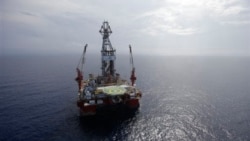On December 26, President Barack Obama signed into law legislation that clears the way for the United States and Mexico to bring the U.S.-Mexico Transboundary Hydrocarbons Agreement into force. The Agreement will establish an environmentally safe and responsible framework to explore and develop hydrocarbon resources that straddle the maritime boundary between the two countries. The Agreement represents the enduring strength of cooperation between the United States and Mexico, including on environmental matters.
The U.S.-Mexico Transboundary Hydrocarbons Agreement enables U.S. offshore oil and gas companies and Mexico’s Petróleos Mexicanos (PEMEX) to jointly develop hydrocarbon reservoirs that cross the U.S.-Mexico maritime boundary, removing uncertainties about development of transboundary energy resources in the Gulf of Mexico.
Agencies from both countries will review all plans for the development of cross-boundary reservoirs to ensure environmentally responsible development and compliance with applicable laws and regulations. Additional requirements might be set before development activities are allowed to begin.
As a result of the agreement, about 607,000 hectares of the U.S. Outer Continental Shelf will be more accessible for exploration and production. According to the U.S. Department of Interior’s Bureau of Ocean Energy Management, the area contains as much as 172 million barrels of oil and over 92 billion cubic meters of natural gas.
“The agreement makes available promising areas in the resource-rich Gulf of Mexico and establishes a clear process by which both governments can provide the necessary oversight to ensure exploration and development activities are conducted safely,” Secretary of the Interior Sally Jewell said in a December 23 statement.
Resources in an area of the Gulf of Mexico known as the Western Gap that were off limits to both countries under a previous moratorium will be opened for exploration to both countries, she said.
U.S. companies and PEMEX may jointly develop reservoirs that cross the maritime boundary. However, if they cannot reach consensus, the agreement establishes the process through which they individually may develop the resources on each side of the boundary while protecting each nation’s interests and resources.
This agreement is consistent with a longstanding record of cooperation, including on energy and environmental issues, between Mexico and the United States. In July 2013, Canada, Mexico and the United States agreed on an action plan to improve environmental standards in the transportation sector, to act on climate change and to improve air quality.
The U.S.-Mexico Transboundary Hydrocarbons Agreement enables U.S. offshore oil and gas companies and Mexico’s Petróleos Mexicanos (PEMEX) to jointly develop hydrocarbon reservoirs that cross the U.S.-Mexico maritime boundary, removing uncertainties about development of transboundary energy resources in the Gulf of Mexico.
Agencies from both countries will review all plans for the development of cross-boundary reservoirs to ensure environmentally responsible development and compliance with applicable laws and regulations. Additional requirements might be set before development activities are allowed to begin.
As a result of the agreement, about 607,000 hectares of the U.S. Outer Continental Shelf will be more accessible for exploration and production. According to the U.S. Department of Interior’s Bureau of Ocean Energy Management, the area contains as much as 172 million barrels of oil and over 92 billion cubic meters of natural gas.
“The agreement makes available promising areas in the resource-rich Gulf of Mexico and establishes a clear process by which both governments can provide the necessary oversight to ensure exploration and development activities are conducted safely,” Secretary of the Interior Sally Jewell said in a December 23 statement.
Resources in an area of the Gulf of Mexico known as the Western Gap that were off limits to both countries under a previous moratorium will be opened for exploration to both countries, she said.
U.S. companies and PEMEX may jointly develop reservoirs that cross the maritime boundary. However, if they cannot reach consensus, the agreement establishes the process through which they individually may develop the resources on each side of the boundary while protecting each nation’s interests and resources.
This agreement is consistent with a longstanding record of cooperation, including on energy and environmental issues, between Mexico and the United States. In July 2013, Canada, Mexico and the United States agreed on an action plan to improve environmental standards in the transportation sector, to act on climate change and to improve air quality.

















